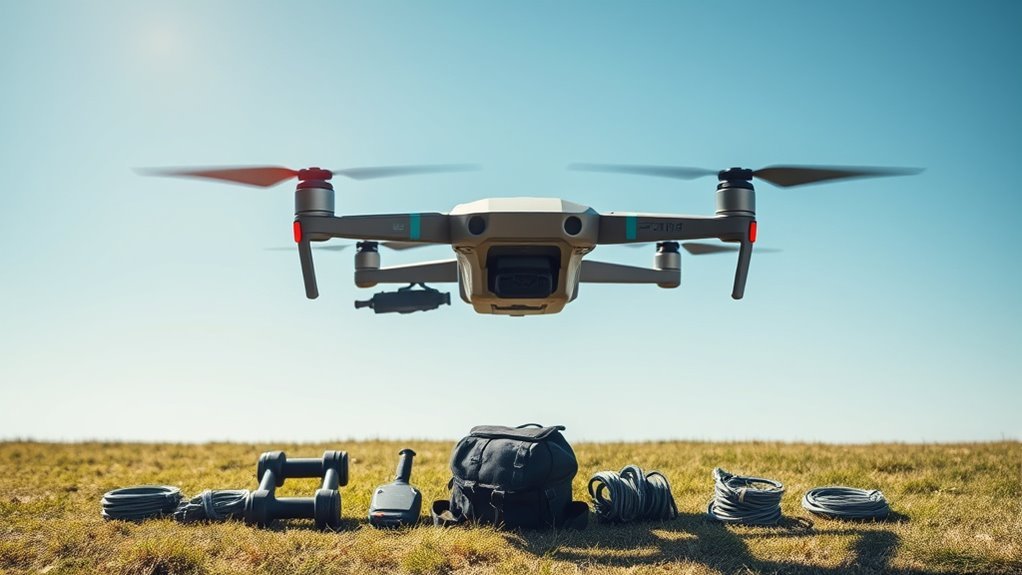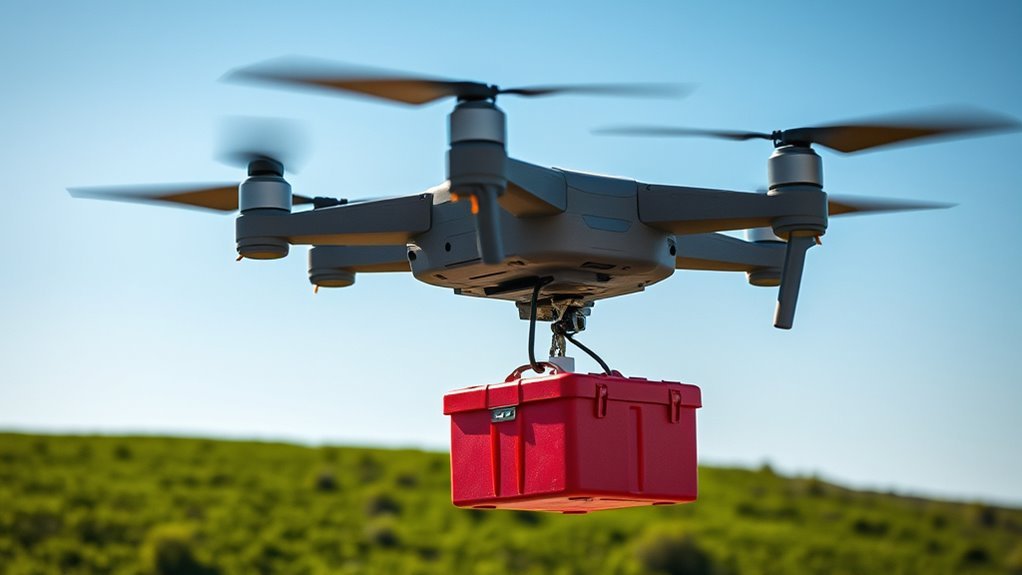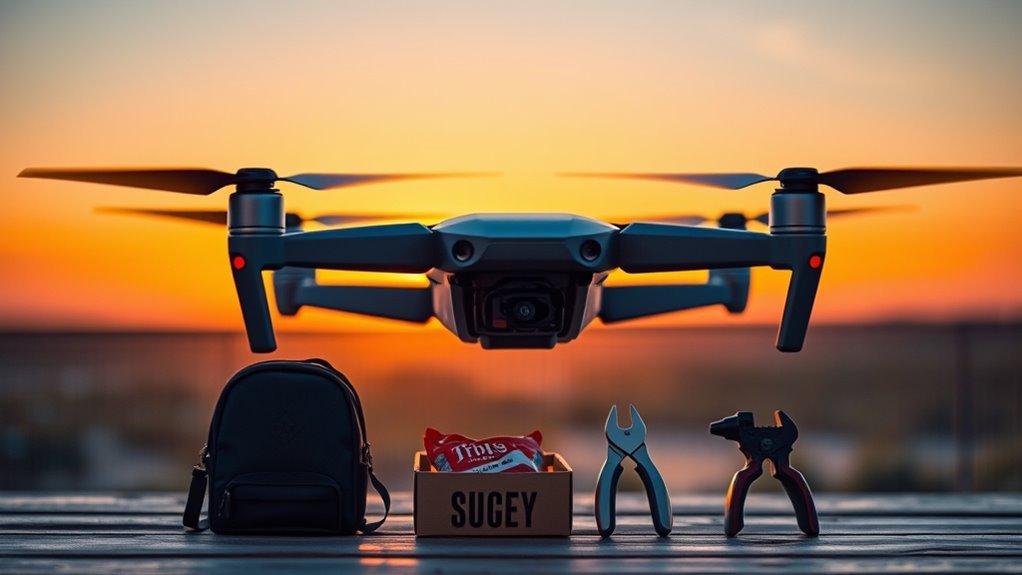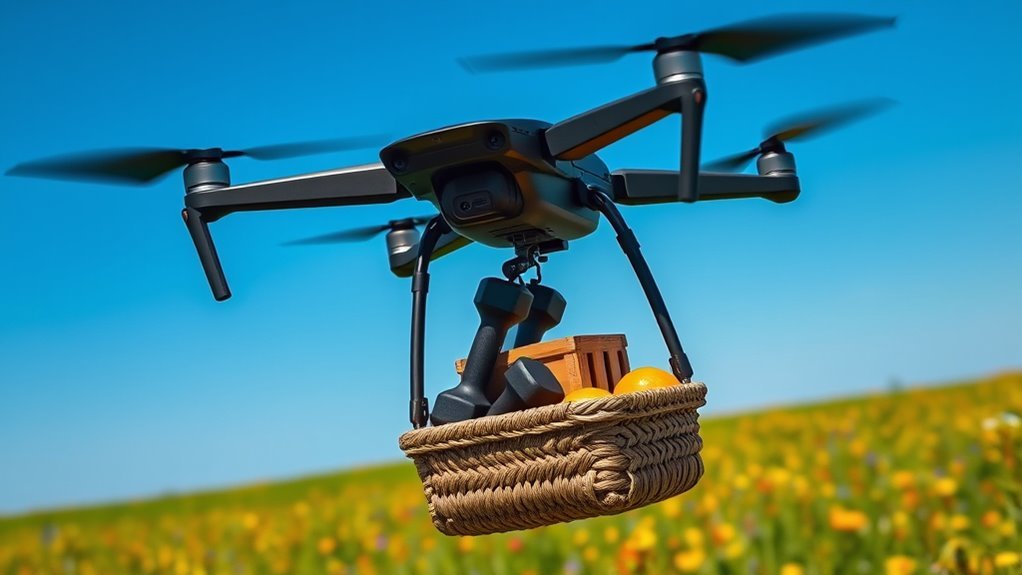Drones typically carry payloads between 1 to 50 pounds, depending on their type and design. Commercial drones handle heavier loads efficiently, while hobbyist drones are limited to lighter weights. Factors like materials, structural integrity, and power output influence a drone’s capacity. Proper weight distribution is essential for stability during flight. Understanding these nuances guarantees ideal usage and compliance with regulations. If you’re interested in more details regarding specific applications, you’ll uncover further insights ahead.
Understanding Drone Payload Capacity

Payload capacity is a crucial specification for any drone, determining how much weight it can effectively transport. When evaluating a drone’s capabilities, consider its design; the materials used and the overall structure greatly impact its payload. Efficient weight distribution plays an essential role in maintaining stability and maneuverability during flight. If you overload a drone, not only will it struggle to lift off, but its performance will degrade, potentially compromising safety. Understanding these parameters allows you to maximize your drone’s potential. The Dji Mini 2’s lightweight materials enhance flight efficiency while maintaining structural integrity. If you’re aiming for freedom in aerial applications, meticulous attention to payload limits and design intricacies is necessary. By knowing how weight affects flight dynamics, you can guarantee your drone performs effectively under various conditions. Additionally, different drone types have varying payload capacities, impacting their suitability for specific tasks.
Factors Affecting Weight Limitations

Several key factors influence the weight limitations of a drone, each playing an essential role in its performance and efficiency. First, the drone design dictates the materials used and structural integrity, impacting how much weight it can safely carry. Additionally, the modular design of certain drones can enhance their adaptability for varying payloads. Second, weight distribution is vital; uneven load placement can destabilize flight and reduce maneuverability. Furthermore, battery capacity and power output must be considered, as heavier payloads require more energy for lift and extended flight time. Finally, environmental conditions, like wind resistance and altitude, can affect a drone’s ability to carry weight effectively. By understanding these factors, you can better assess the capabilities of your drone and optimize its performance for your specific needs. Moreover, battery life and flight duration are critical in determining how much weight a drone can effectively manage before it risks compromising flight time and stability.
Types of Drones and Their Carrying Capacities

Drones come in various types, each designed for specific applications and carrying capacities. Understanding these classifications helps you choose the right drone for your needs. Here’s a quick overview:
Drones vary in type and capacity, allowing users to select the perfect model for their specific needs.
- Commercial Drones: Capable of carrying heavier payloads, typically ranging from 5 to 50 pounds, ideal for deliveries, inspections, and agricultural tasks. These drones often leverage advanced imaging technology to enhance their operational efficiency.
- Hobbyist Drones: Generally lighter, with maximum payloads around 1 to 5 pounds, suitable for recreational use, photography, and light videography.
- Racing Drones: Designed for speed and agility, they usually carry minimal weight, focusing on performance rather than payload capacity. Additionally, understanding material composition is vital for strategizing optimal drone usage based on its carrying capacity.
Regulatory Considerations for Drone Payloads
While you may be keen to utilize a drone for carrying cargo, it’s vital to understand the regulatory framework governing payload limits. Drone regulations vary markedly by country and region, often dictating maximum weight allowances for safe operation. These payload restrictions secure airspace safety and mitigate risks associated with overloading. Compliance with these regulations not only protects your investment but also fosters a responsible drone usage culture. Before you commence transporting goods, familiarize yourself with local laws, required certifications, and the specific weight limits applicable to your drone model. Ignoring these guidelines can lead to legal repercussions and jeopardize operational integrity. Consequently, staying informed about the regulatory landscape is essential for maximizing your drone’s capabilities while guaranteeing compliance and safety.
Practical Applications of Drones in Weight Carrying
Understanding regulatory considerations sets the stage for exploring the practical applications of drones in weight carrying. Drones are revolutionizing various sectors, enabling efficient operations and enhancing productivity. Here are three key applications:
- Drone Deliveries: They’re transforming last-mile logistics, allowing businesses to deliver packages swiftly, minimizing transport costs, and reaching remote areas.
- Agricultural Applications: Drones can carry payloads for precision agriculture, such as distributing seeds or fertilizers, optimizing resource use, and improving crop yields. Drones like the Guardian Agriculture Drone utilize advanced sensors for efficient crop monitoring.
- Emergency Response: In disaster scenarios, drones can transport medical supplies or food to inaccessible locations, ensuring timely aid.
Frequently Asked Questions
Can Drones Carry Animals or Pets Safely?
You need to contemplate drone safety and the specific design for animal transport. Drones can carry small pets securely, but guarantee they’re well-contained, monitored, and that the flight path minimizes stress for the animal.
How Do Weather Conditions Affect Drone Payload Capacity?
Weather conditions greatly impact drone payload capacity. High winds increase wind resistance, which can limit stability and control. Additionally, extreme temperatures affect battery performance, reducing efficiency and overall weight-carrying ability during flight.
Are There Specific Drones for Carrying Food Deliveries?
Around 70% of consumers prefer drone delivery for food. Numerous specialized drones exist for food delivery, optimizing drone logistics to guarantee timely and efficient service, often tailored for specific payload capacities and operational environments.
What Is the Maximum Height for Carrying Heavy Payloads?
When considering maximum height for carrying heavy payloads, drone altitude restrictions typically align with payload regulations. You’ll need to check local laws, as they vary widely, impacting your operational freedom and efficiency in delivery missions.
Can Modifications Increase a Drone’s Carrying Capacity?
Like Icarus soaring too close to the sun, you can modify a drone for increased payload upgrades, enhancing carrying efficiency. However, be cautious; too much modification may compromise stability and performance, risking the flight’s success.

